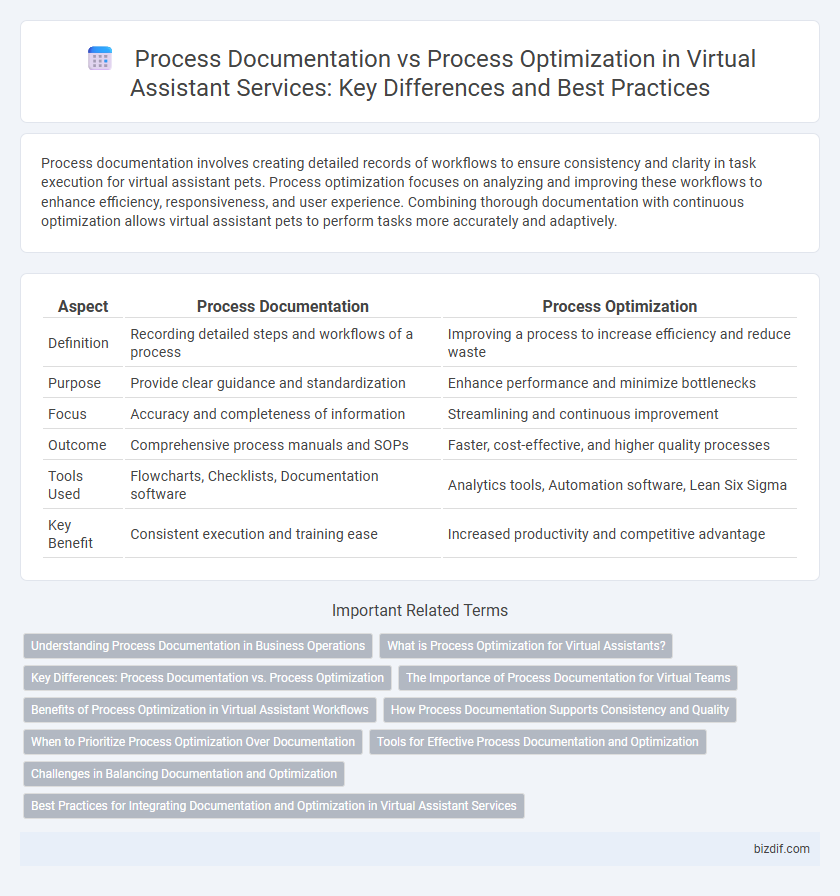Process documentation involves creating detailed records of workflows to ensure consistency and clarity in task execution for virtual assistant pets. Process optimization focuses on analyzing and improving these workflows to enhance efficiency, responsiveness, and user experience. Combining thorough documentation with continuous optimization allows virtual assistant pets to perform tasks more accurately and adaptively.
Table of Comparison
| Aspect | Process Documentation | Process Optimization |
|---|---|---|
| Definition | Recording detailed steps and workflows of a process | Improving a process to increase efficiency and reduce waste |
| Purpose | Provide clear guidance and standardization | Enhance performance and minimize bottlenecks |
| Focus | Accuracy and completeness of information | Streamlining and continuous improvement |
| Outcome | Comprehensive process manuals and SOPs | Faster, cost-effective, and higher quality processes |
| Tools Used | Flowcharts, Checklists, Documentation software | Analytics tools, Automation software, Lean Six Sigma |
| Key Benefit | Consistent execution and training ease | Increased productivity and competitive advantage |
Understanding Process Documentation in Business Operations
Process documentation in business operations involves creating detailed records of workflows, tasks, and protocols to ensure consistency and clarity across teams. This foundational practice enables employees to follow standardized procedures, reducing errors and improving training efficiency. Clear documentation serves as a baseline for process optimization efforts, allowing businesses to identify bottlenecks and streamline operations effectively.
What is Process Optimization for Virtual Assistants?
Process optimization for virtual assistants involves analyzing and refining workflows to improve efficiency, accuracy, and response times in task execution. It focuses on automating repetitive tasks, minimizing errors, and streamlining communication to enhance overall productivity. Effective process optimization enables virtual assistants to deliver faster, more reliable support while reducing operational costs.
Key Differences: Process Documentation vs. Process Optimization
Process documentation involves creating detailed records of workflows, procedures, and tasks to ensure consistency and clarity in execution. Process optimization focuses on analyzing and improving these documented processes to enhance efficiency, reduce errors, and increase productivity. Key differences lie in documentation's emphasis on capturing current practices, while optimization targets refining and streamlining those practices using data-driven insights and performance metrics.
The Importance of Process Documentation for Virtual Teams
Process documentation is essential for virtual teams, providing clear guidelines and standardized workflows that enhance communication and reduce errors across dispersed members. It enables seamless onboarding, knowledge retention, and accountability, which are critical when team members work remotely. While process optimization focuses on improving efficiency, thorough documentation lays the foundation that ensures consistency and scalability in virtual collaboration.
Benefits of Process Optimization in Virtual Assistant Workflows
Process optimization in virtual assistant workflows enhances efficiency by streamlining repetitive tasks and reducing errors, leading to faster response times and improved client satisfaction. It enables the integration of advanced AI tools to automate routine processes, increasing productivity and allowing virtual assistants to focus on higher-value activities. Optimized workflows also facilitate better resource allocation and continuous performance improvement, driving overall operational excellence.
How Process Documentation Supports Consistency and Quality
Process documentation creates a standardized framework that ensures tasks are executed uniformly across teams, reducing errors and enhancing quality control. Detailed documentation enables virtual assistants to follow precise procedures, leading to consistent outcomes and improved customer satisfaction. By capturing best practices and workflows, process documentation supports continuous improvement and drives operational efficiency.
When to Prioritize Process Optimization Over Documentation
Process optimization should be prioritized over documentation when workflow inefficiencies directly impact productivity, resource allocation, or customer satisfaction within a virtual assistant environment. Focusing on streamlining tasks and eliminating bottlenecks enables faster response times and improved accuracy, which are crucial for maintaining competitive service standards. Investing in advanced process mapping and analytics tools helps identify areas where optimization offers the most significant operational gains before formalizing process documentation.
Tools for Effective Process Documentation and Optimization
Effective process documentation and optimization rely heavily on tools such as workflow management software, digital whiteboards, and process mapping applications. Platforms like Lucidchart, Microsoft Visio, and Process Street enable detailed visualization and standardization of workflows, facilitating clarity and consistency. Optimization tools with analytics capabilities, including Nintex and Kissflow, help identify bottlenecks and automate repetitive tasks, driving enhanced operational efficiency.
Challenges in Balancing Documentation and Optimization
Balancing process documentation and process optimization poses challenges such as allocating sufficient time to create detailed records without hindering workflow improvements. Excessive focus on documentation can slow down agility, while prioritizing optimization may lead to overlooked or outdated procedures. Virtual assistants help maintain accuracy by automating documentation updates alongside optimization efforts, ensuring processes remain efficient and well-documented.
Best Practices for Integrating Documentation and Optimization in Virtual Assistant Services
Effective virtual assistant services rely on thorough process documentation to establish clear workflows and ensure consistency across tasks. Integrating process optimization techniques such as workflow automation and performance analytics enhances productivity by identifying bottlenecks and streamlining operations. Combining detailed documentation with continuous optimization enables virtual assistants to deliver scalable, high-quality support aligned with evolving business needs.
Process documentation vs Process optimization Infographic

 bizdif.com
bizdif.com